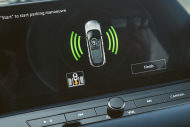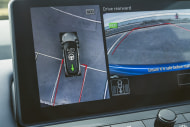
Top parking tips
Parking is a day-to-day necessity, but it’s one of the things that some drivers dread most. The margin for error is small - take the wrong line into a space, and you might end up scraping your car, another car or even kerb your wheels on the gutter.
Parking is a day-to-day necessity, but it’s one of the things that some drivers dread most.
The margin for error is small - take the wrong line into a space, and you might end up scraping your car, another car or even kerb your wheels on the gutter.
- If you don’t think you’ll fit, don’t try
- Use the reversing camera, but also use your mirrors and your common sense
- Know the size of your car!
We’ve all had one of those moments where we do something silly when parking, end up accidentally causing damage, and realise afterwards that we were thinking about something else, looking at something else, or listening to that favourite tune or the “whodunnit” part of the podcast when the incident occurred.
If you want to minimise the chance of having any parking problems, here are a few tips to consider.
Turn the stereo down.
It might seem odd, but have you ever noticed that when you’re looking for an address or searching for a parking spot in a packed shopping centre car park, it seems easier if you turn the radio off? That’s because your brain is saying, “I can’t concentrate on all of these things!”.

You’re using your hands and feet to control the movement of the car, and you are also using your brain and eyes to try and find a spot. If you lessen the mental load by simply hitting pause, mute or turning the volume right down on your car’s stereo, you will find it easier to get where you need to go.
Know the size of your car.
We’re not suggesting you enrol in a Learner Driver program to figure out the size of your vehicle, but honestly, you need to consider the physical dimensions and limitations of your car.

We’ve all got friends that have upsized from a small city hatchback to a larger SUV, only to be perplexed about how much harder it is to park. Sadly, the fact is that SUVs are typically taller, wider and longer than passenger vehicles, and since the majority of people today buy SUVs, it means that the parking spaces are seemingly getting smaller and smaller.
If you aren’t sure about fitting into a spot, park further away and walk.
What’s cheaper and better for you than crunching your bumper into a concrete wall? Everything!
But seriously, if you feel like you won’t fit in a spot, don’t try. Park elsewhere and walk to where you need to get to, if you can. You’ll lower your stress levels, you’ll lessen the chance of someone else dinging your car with their doors on side-swiping it when parking, and you will get a little bit of bonus exercise.
Use the parking aids available to you.
A reversing camera comes as standard on pretty much every new car these days, and plenty even have terrific surround-view camera systems to help you park more easily.

A rear-view camera can help you judge whether you’ve got the angle right when you’re reverse parallel parking, or backing into a parking space. A surround view camera is great to give you an overhead view of what is around the car, and may even alert you to solid objects that mightn’t have been within view from your mirrors.
Cameras also act as safety aids. Please, if you have children or are parked near where children may be, always walk around your car and check your camera and mirrors before reversing out of a space.
Try and park a car on a test drive.
If you are looking at buying a car, do a parking manoeuvre in it. If you typically park on a busy street with reverse-parallel parking, don’t avoid doing that sort of park.

I know, you don’t want to damage a car before you’ve even bought it. But you also don’t want to buy a car that you can’t easily park.
Adjust your mirrors.
Some cars have this amazing trick where they will dip the side mirrors to allow you to get a better view of the kerb when you’re doing a reverse-parallel park.
If you car doesn’t have that, and you’re conscious of not bumping your rims into the unforgiving gutter, take a second or two and adjust your mirrors. The people honking will get over it, and you’ll get into the spot without hurting your car or your pride.
Look before you leave.
Before you leave your parking space - whether you’re driving out or reversing out - check around the car. Sometimes you won’t see that someone else has parked very close to you on one side of the car, and you don’t want to be the one who has to leave a note explaining it was their fault for you swiping the side of their car.
Also, be sure that, if you’re getting out of a parallel park, you check over your shoulder as well as in your mirrors. Lots of cars have blind-spot monitoring, which will alert you if you may have missed something coming up from behind you, but there is nothing better than a glance with your eyes to make sure you can’t see anything, too.

More Urban Guide


